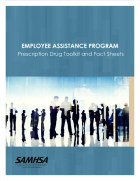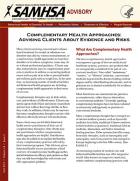This updated TIP reviews what is known about treating the medical, psychiatric, and SUD-related problems associated with the use of cocaine and methamphetamine, as well as the misuse of prescription stimulants. The TIP offers recommendations on treatment approaches and maximizing treatment engagement and retention, and strategies for initiating and maintaining abstinence.
Dashboard: Filter Bricks
Main page content

The EAP Prescription Drug Toolkit and Fact Sheets provide guidance related to counseling, referrals, and follow-up services (e.g., alternatives to prescription drugs, workplace drug misuse and relapse prevention, dangers of combined drug use, screenings, and evaluations before returning to work).

This advisory for behavioral health practitioners provides a brief overview of complementary health approaches. It describes the practices and products that are considered complementary, and explains how practitioners can help patients understand the benefits and risks.

This manual helps clinicians design and implement intensive outpatient treatment programs for people living with substance use disorder conditions. It discusses cultural competence and approaches, use of 12-step programs, cognitive behavioral therapy, and therapeutic communities.

This guide helps substance use counselors treat clients with symptoms of depression and substance use conditions. Program administrators will learn how to integrate depression treatment into early drug treatment. The guidelines cover screening, assessment, treatment, counseling, cultural competence, and continuing care.

This resource guide presents healthcare professionals working with people living with physical and sensory disabilities with information about substance use disorders, including risk factors and warning signs. It also discusses screening, types of substance use services, and strategies for helping clients.


